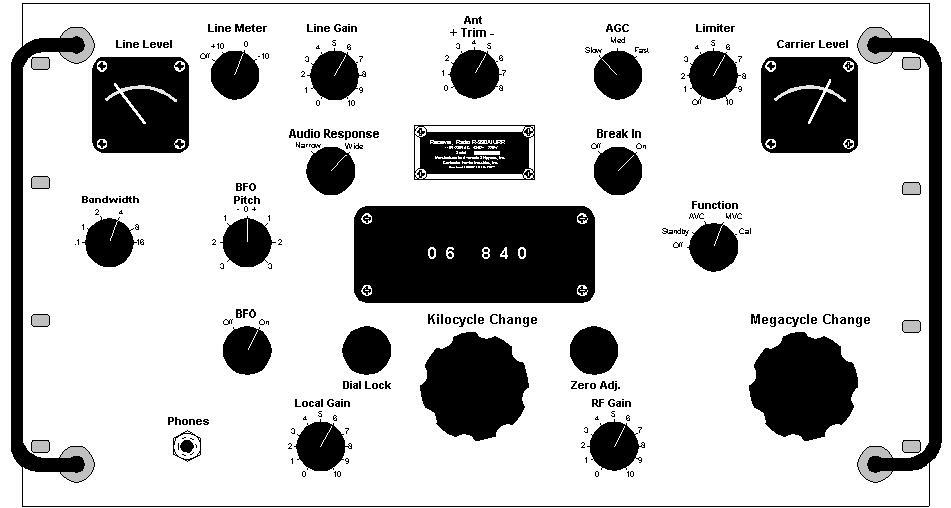| The R-390A Frequently Asked Questions Page |
|---|
|
Overview |
| This document is a compilation of the wisdom shared by members of the online community of R-390A enthusiasts. As such, it is advice to those who endeavor to maintain and restore the R-390A family of receivers. The information is shared without warranty, expressed or implied. This information is in the public domain and can be freely copied or shared. Appropriate attribution is appreciated. |

|
|
The R-390A is the most prevalent of one series of high performance High Frequency (HF) receivers designed by the Collins Radio Company. The R-390A design is a lower cost version of the Collins R-390 military receiver. Various manufacturers produced the R-390A in large quantities from 1953 to 1984. |
|
|
The R-390A predecessors included the receivers 51-J1, 51-J2, 51-J3 and 51-J4, and their amateur-bands-only counterparts -- the 75A1, 75A2, 75A3 and 75A4. These radios carried on a Collins Radio Company engineering tradition of ever-increasing equipment performance. Collins manufactured them from 1947 to 1962. Many considered them to be the finest examples in their day of radio receiver engineering. In 1950, Collins introduced the R-390, the immediate predecessor to the R-390A. |
|
|
The R-390A is 10.5 inches high, 16.8 inches deep, and fits a standard 19 inch EIA rack opening. The receiver weighs approximately 85 pounds. The receiver operates on 115/230 volt, 60 hertz power. It consumes 225 watts when the crystal ovens are on, and 140 watts when they are off. Rack handles mounted on the front panel enable placing the receiver on its face without resting on the front panel control knobs. Side panel extensions permit positioning the receiver on its rear panel without resting on the rear connectors and controls. |
|
|
The R-390A receiver operates from 0.5 MHz through 32 MHz and is continuously tunable in 32 bands. It offers six IF bandwidths designed to accommodate CW, AM and RTTY signals. The receiver has two antenna inputs, one for short whip antennas and another for balanced antennas. A separate IF output is available for specialized uses. The receiver supports diversity operation and control. The R-390A is capable of break-in operation for use with a local transmitter. Twin audio outputs for local and line applications are available. Inductively tuned oscillators and tracking filters extensively augment the mechanical filters in the IF amplifier. |
|
|
The design intended that the R-390A receiver be used for military and government intelligence signals intercept operations, point-to-point radio circuit operation, operation from field transportable communications shelters and shipboard communications. The receiver maintains nominal operation in an environment that contains high-energy RF fields and EMP radiation. |
|
|
The R-390A is relatively plentiful, which keeps the cost of obtaining a working specimen and the task of locating parts relatively simple. Many radio enthusiasts desiring the best possible AM and CW performance possible from a HF receiver use the R-390A. It is highly prized by shortwave radio listeners, Broadcast Band DX-er's, Utility Monitors and other skilled users of the HF spectrum. |
|
|
Very few examples of best-in-class technological longevity exist. The Collins-designed R-390A was produced from 1953 to 1984. This receiver often proves to be, after more than fifty years, one of the best vacuum tube short-wave receivers available for AM, CW and RTTY use. |
|
|
The R-390A's ability to consistently perform well in a very harsh local signal environment where powerful transmitters are nearby puts this receiver in the company of exceptionally few short-wave receivers. The R-390A's installation flexibility allows remote control of AGC level, remote adjustment of RF gain, diversity operation, attachment of external demodulators and monitoring devices, and break-in operation. |
|
|
The radio contains six field-replaceable subassemblies that make servicing easier. Its construction and maintenance appear technically intimidating, but in reality is relatively easy to work with when one follows the published technical procedures. The receiver uses an elaborate gear and cam mechanism to control the tuning slugs in the antenna, RF amplifier, and Mixer sections. |
|
|
The R-390A has:
|
|
|
|||
|
|
|---|